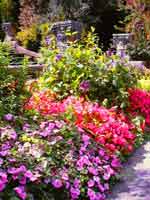



Custom Search
|
|
"People will not look forward to posterity who never look backward to their ancestors." Quotes Shops Ireland Bunús na Gaeilge Did You Know? Himself/Herself Write to Us Readers Write.. Links/Link to Us Advertise with us Awards & Testimonials |
Haymaking in Ireland long ago After the hay had been cut into swaths, it was left to dry for a couple of weeks and then it was turned by fork for drying on the other side. It was then shaken out and made into cociní (cockeens, cutyeens or lapcocks). Unless the hay was already very dry, these were left in the fields for a few more days to dry out some more. Once they were fully dry, the cociní were shaken out for a second time and built into proper haystacks between seven and eight feet tall. Súgans, or hayropes were then twisted and drawn over the stacks to secure them; heavy stone weights at the ends of the ropes held them down in high wind. The farmer would also "head" the stacks by raking all the loose hay from the top to tidy it and then he would use a pitchfork to put the loose hay back. Hauling home the hay to the haggard In her book, The Festive Foods of Ireland, Darina Allen recalls that as late as the 1960s, haycarts were still horse-drawn. She also remembers that gathering the hay was a community event, when everyone in the village pitched in to help each other, moving from farm to farm as they did at harvest time. "As children we were welcome in every house and adored all of the excitement. We raced into the fields after school, flinging our satchels into the headlands. The boys were full of importance helping to make the haystacks but I would rush into the farm kitchen to help with the tea. Spotted Dog (a type of fruit bread) and apple or rhubarb cake were the standard fare and I was sometimes allowed to peel the apples or chop the rhubarb or best of all, roll out the trimmings of pastry. As soon as everything was baked, great big teapots of strong tea were brewed and poured into a tin can with a lid or into whiskey bottles which were then wrapped in several layers of newspaper. Haymaking, like harvesting, was thirsty work, so we always got a great welcome, Everyone gathered, and sitting up against a haystack, drank hot sweet tea and ate thick slices of warm fruit bread smothered with country butter, followed by apple cake." The benefits of making hay the old way Without question, the old-fashioned way took more time than modern methods, but the exercise was good, the air was fresh, and it was an event that brought a farming community together. Additionally, the simple tools and equipment were very well built and easy to maintain. In fact, the farm machinery built in the latter part of the horse-drawn era was made to last forever. There were other benefits as well. In this era of powerful agricultural equipment, it would be dangerous to allow young children around a modern round baler. But, in old Ireland, kids grew up working alongside the adults and undoubtedly, thoroughly enjoyed the rides in the hay cart back and forth. Perhaps some of you came from a rural background and can remember the joy of jumping into the haystacks? Black & white shot is kindly provided by our friend and subscriber in England - Patricia Edwards. It was taken when she visited her grandparents in Kilmurry McMahon, Co. Clare in 1958. She is the 16 year old in front with the pitchfork. Besides bringing a village and generations of a family together there was also the benefits inherent in having to keep a closer eye on the animals. As opposed to today's method of often dumping a round bale and just leaving it for a couple of days, our farmer of old would probably have filled his feeders at least twice a day. Thus, he would know a lot sooner which animals were sick, not eating, or ready to give birth. But best of all, there was the satisfaction of knowing that when the cold winds of winter came, the fodder in the haggard would feed the animals in the fields; fodder provided for by a community of people working side by side, and by God's gift of good summer weather. |
 Ilnacullen, Co. Cork - an Island Garden Ilnacullen, Co. Cork - an Island GardenLocated in the sheltered harbour of Glengarriff in Bantry Bay. Ilnacullin, which means island of holly, is a small island known to horticulturists and lovers of trees and shrubs all around the world as an island garden of rare beauty.
|
||||||||||
|
|
||||||||||||
| All contents copyright © 2001 through 2011 inclusive - all rights reserved. March 4, 2011 |
Rollover button Images: Wedding LaRose, Kids Reading & Kitchen Apples and Tea from All Posters prints. The information provided on this site is offered as-is, without warranty. This site's owners, operators, authors and partners disclaim any and all liability from the information provided herein. Any trademarks or registered trademarks on this site are the property of their respective owners. |
This Web Site Bashed, Kicked & Glued together by Russ Haggerty. |
||||||||||